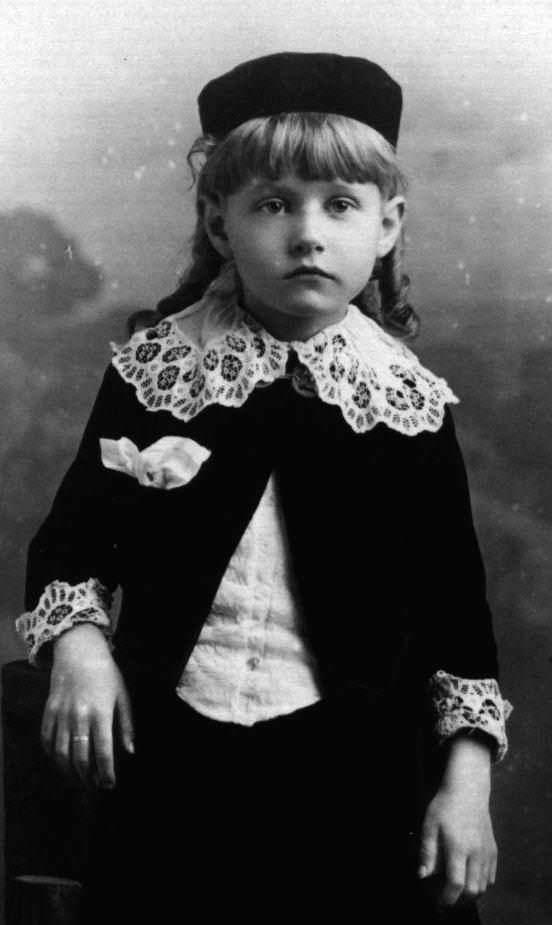
Little Lord Fauntleroy Kilt Suits: Collars

Figure 1.--This American boy, probably in the 1890s, wears a black Fauntleroy-styled kilt suit. Rather than a heavily trimmed blouse, this boy wears a pinned on lace collar. Notice the matching wrist cuff trim that has also been pinned on. He wears his collar without a bow, presumably because his mother wanted to show off the lace to best effect.
|
Mothers employed two basic types of lace collars with Fauntleroy outfits, fancy heavily trimmed blouses and separate lace collars pinned on to the jacket. The blouses were usually worn in the the 1880s with the pinned-on lace collars becoming more common in the 1890s. The lace collars were the same ones that might be worn with a classic Faintleroy suit.
Basic Collar Types
Blouses
The first involved fancy blouses with lace collars and
cuffs as well as front trim in many cases. These blouses varied greastly
in style and trim. Some were amazingly fancy for a boy including ruffles
and lace almost beyond belief. Others were quite plain.
Pinned on collars
The second involved a separate lace or ruffled collar that was pinned on to the jacket. This was a less expensive approach to the Fauntleroy style. It is sometimes easy to determine which is which as the separate lace collar might not have matching wrist trim. Those that did, however, often look quite detinct to the fancy blouses.
Fauntleroy Suits
The blouses and pinned on collars were no different than those worn with Fauntleroy suits after brreching. In fact many boys after being breeched and wearing kneepants, wore the same jackets, blouses and collars, and bows with the same headwear that they had worn while still wearing Fauntleroy and other kilt suits.
Frances Hodgson Burnetts's book Little Lord Fauntleroy was published in 1885. The book and susequent draatizations caused a sensation ' in boy's fashions. Boys had wotn velvet suits and lace collars before the book was published, but
the book popularized the style and doting mothers proceeded to inflict it upon a generation of unsuspecting boys. Some of the collars worn with Fauntleroy suits were worn without bows. Others used a bow as a major fashion accesory. The bows came in many sizes and patterns, This was a major fashion shift because until the 1880s, boys generally wore only
small bow ties or bows.
The classic Little Lord Fauntleroy suit was worn with a small velvet jacket worn open at the front to best display the elaborate ruffled and lace trimed blouses. The blouses came in a miriad of materials and styles. There were two basic types of Fauntleroy bloyses. Some had lace collars and others ruffled collars. The lace collars were more common in the classic Fauntkeroy era, from about 1885-1895. As the turn of the century appraoched, the ruffled collars became increasingly common. There were also many Fauntleroy blouses with lace trim worked into ruffled collars. They were very common in the classic era.
It was Frances Hodgson Burnett's book Little Lord Fauntleroy in 1885, however, that popularized a revival of elaborate 17th century fashions for little, and not so
little, boys. One esential part of any Fauntleroy suit was a blouse with a elaborate lace collar or a lace collar attached to the jacket. These collars were worn through
the Edwardian period strarching into the 1910s. Subsequently, open necked ruffled collars began to replace the lace collars boy's velvet suits.
Ruffled collars are today primarily associated with girls' and women's wear. For several centuaries, however, ruffled collars were commonly worn by boys and in previous centuries, even men. They were in fact an important part of the well-dressed man's wardrobe. At the time boys after breeching wore small-scale versions of the father's clothes. Ruffled collars were very commony in the early 19th century for boys with both tunics and skeleton suits. Their popularity wained in the 1880s as lace collars were generally worn with Fauntleroy suits during the classical period. After the turn of the century, Fauuntleroy suits continued to be worn until the early 1920s, but increasingly with ruffled rather than lace collars. Since the 1920s, boys have no longer worn ruffled collars, except for special costumes like wedding ring bearers or coral performances.
Christopher Wagner

Fauntleroy Related Pages:
[Returnt to main Fauntleroy kilt suit page]
[Edwardian Fauntleroy suits]
[Final Fauntleroy period]
[Fauntleroy dresses]
[Lace collars]
[Vivian Burnett]
[Fauntleroy patterns]
Other Related Pages:
[Dresses]
[Kilts]
[Smocks]
[Pinafores]
[Sailor Hats]
[Blouses]
[Ring Bearers]
[Long hair]
[Ringklet curls]
[Hair bows]
[Bangs]
[Collars]
[Bows]
Navigate the Boys' Historical Clothing Web Site:
[Return to clothing styles]
[Introduction]
[Activities]
[Biographies]
[Bibliographies]
[Chronology]
[Countries]
[Contributions]
[FAQs]
[Glossaries]
[Satellite sites]
[Boys' Clothing Home]
Created: December 20, 2001
Last updated: December 20, 2001



